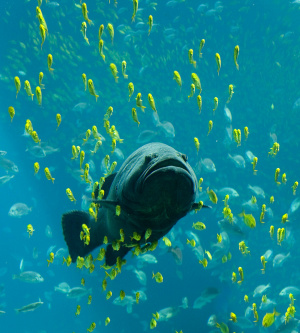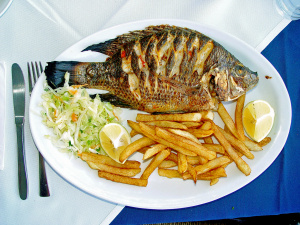Fish



fish is an aquatic creature that lives in water, has gills and is cold-blooded.
Fish are mentioned many times in the Torah. Besides their use for food and their kosher signs, they serve as a mashal (metaphor) for blessing since they live in a covered place (called in Chassidus "alma d'iskasya") and are an example of those who are not affected by ayin hara (evil eye). Additionally, they serve as a mashal for reproduction without physical desire, and also represent complete tzaddikim.
Reproduction[edit | edit source]
Fish are used in the verse as a mashal for great multiplication (fish lay dozens of eggs in one laying) as it is written "v'yidgu larov b'kerev ha'aretz" (they shall multiply abundantly like fish in the midst of the earth), and Chazal add that fish are not affected by ayin hara.
In Chassidus it is explained that the reason reproduction is appropriately compared to fish is because fish are cold and have no desire (fish reproduction occurs through the male depositing seed on the female's eggs in the water), and their multiplication is not done through desire, which indicates reproduction for the sake of Heaven and not for desire.
Soul Reincarnation in Fish[edit | edit source]
The neshamos of tzaddikim reincarnate in fish, and the neshamos of tzaddikim and talmidei chachamim sometimes descend into fish since tzaddikim are attached and connected "to complete unity with Elokus... in absolute bitul" therefore their neshamos reincarnate in fish since fish cannot exist without water. To one chossid who got a fish bone stuck in his throat, the Alter Rebbe said: "The neshamos of tzaddikim one needs to know how to eat." Tzaddikim elevate to the level of chesed through being elevated thus to their neshamah's root.
Sea Fish (Nunei Yama)[edit | edit source]
The term "nunei yama" is mentioned frequently in the holy Zohar as a mashal for tzaddikim of the highest level, like Rav Hamnuna Saba, one of the elder Tanaim of the Zohar. Regarding this, the Alter Rebbe explains that the movement of tzaddikim called nunei yama is wondrous and very elevated, like the mashal of fish swimming in the sea - they swim and in one flight reach higher and higher. One of these tzaddikim was the holy Tanna Rabbi Shimon bar Yochai. Therefore, when RASHBI was in the cave, he did not fulfill several practical mitzvos as mentioned above, but rather everything was spiritual, beyond the level of rejoicing with meat etc. This is the concept of the Levyasan's fins with which it swims from one end of the sea to the other. Therefore the entire world stands on the Levyasan which encompasses the whole world, as known in the words of Chazal.
Complete Integration of Fish in the Sea[edit | edit source]
There is an additional explanation in Chassidus regarding fish, which is the aspect of Hashem Echad (G-d is One), which is the drawing down of Daas Elyon whose concept is yichuda ila'ah, which is also called "sea" - as the entirety of the sea is one existence in which everything exists and is included and is not separate from it. Therefore fish do not create a chatzitzah (separation) in a mikvah and are counted in the forty se'ah measure.
This explanation is brought regarding Rav Hamnuna Saba's neshamah being a neshamah of Atzilus from the aspect of neshamos of the supernal sea in Malchus of Atzilus, and therefore he was called Rav Hamnuna from the term "nunei yama". The Rebbe Maharash explains that just as fish in the sea are absorbed in the sea water and the water permeates within them completely such that they are like the essence of the water itself, so too the neshamos of Atzilus like the neshamah of Rav Hamnuna Saba are in a state of complete bitul, to the point that they cannot separate even for one hour, as part of the water itself (in the mashal of the fish), and as our Sages say "a fetus is like its mother's limb", meaning: despite being a fetus with its own distinct existence, nevertheless during the entire pregnancy it is like its mother's limb and is not considered a separate entity, due to its complete bitul to its mother during this time - eating what the mother eats and drinking what the mother drinks etc. Similarly, the neshamos of Atzilus while in the womb of Malchus called Yam Suf are like their mother's limb and completely nullified like a fetus which is its mother's limb and like fish in the sea that are absorbed in the sea water.
Feast of the Shor Habar and the Levyasan[edit | edit source]
In the future, the Levyasan will wage war with the Shor Habar (wild ox) and will slaughter it with its fins. The explanation of this matter is that the avodah of tzaddikim of the second level is called Shor Habar - "the face of an ox from the left", except that it is "bar" (pure) and refined. For even their avodah with physical matters like "rejoicing on your festival" on Yom Tov, and "there is no joy except with meat", is not literal - that one should eat the ox's meat to fill his stomach chas v'shalom and rejoice in it, but rather it is an aspect of elevation like the shelamim offerings of joy from physical meat that existed in the time of the Beis Hamikdash which were literally a "pleasant fragrance to Hashem". This is called "Shor Habar", from the term "bar levav" meaning pure and refined meat, referring to joy for Hashem born from this with flames of fire and enthusiasm. However, nevertheless this level which comes from something physical and limited is smaller compared to the wondrous movement of tzaddikim called Levyasan, whose movement in one flight with coolness and calmness reaches higher and higher which is infinitely greater.
Therefore the Levyasan will slaughter the Shor Habar, meaning it will elevate it through its flight, and this is with its fins through which is its main elevation etc., which is beyond the own power of the tzaddikim called Shor Habar. But in truth the Shor Habar will also elevate the Levyasan because in one aspect their avodah is more elevated even though it is physical avodah, for so it must be according to Torah - "rejoice in your festival" and there is no joy except with meat and wine, and from this aspect it will elevate it. And this Hashem will show the tzaddikim in the future - the entirety of their avodah in this world, that both are good as one.
Eating Fish[edit | edit source]
It is customary throughout all Jewish communities to eat fish at seudos mitzvah and particularly at Shabbos meals, and various reasons are given for this. One of the well-known reasons is that tzaddikim and talmidei chachamim who need tikkun reincarnate in fish, which are creatures that serve as a mashal for the avodah of tzaddikim, and when a person eats fish containing the neshamah of a talmid chacham, he himself merits tikkun, besides elevating the neshamah that needs tikkun.
It is told that during a Shabbos seudah in the court of the Rebbe of Vilednik, they served the Rebbe a platter with two large fish, and immediately the Rebbe began telling: "Do you know how these fish arrived here? Two fish were swimming in the great river, and one fish turned to the other and asked him 'Where are you swimming to?' The fish answered 'To Lubavitch.' 'And where are you going?' asked the fish. 'To Vilednik,' answered the second fish. 'Perhaps you'll come with me to Vilednik?' suggested the fish, and indeed he was convinced and thus they both arrived here" - and in his words he hinted to a Chabad chossid who was present at the tish.
Eating Fish with Meat[edit | edit source]
The Gemara relates that it was forbidden to eat fish roasted with meat because of danger, as Chazal knew that it is "harmful to breath odor and tzaraas". In many matters (like treifos, milah and more) Chazal established halachos based on principles and information that don't necessarily match scientists' opinions today. Therefore even if science would maintain there is no health danger in eating fish and meat together, we rely on Chazal's determination which, being Torah, is absolute, while science constantly changes (and this is its greatness).
Throughout Jewish communities people are careful about this even today, and even discuss if a mixture of fish and meat is nullified in sixty parts like forbidden food. Some are stringent not to cook fish even in a clean pot that was used for meat.
According to the Beis Yosef, one must wash hands between meat and fish. One who ate with a fork and his hands are clean may be lenient with this. According to the Rama, it's sufficient to eat and drink something between meat and fish, and hand washing is not required. In practice, it is customary to say l'chaim on wine or strong drink between fish and meat. The Chabad Rebbeim were also accustomed to rinse their hands with some water. The poskim were also stringent not to bring meat and its dishes to the table while the fish had not been cleared from it.
Eating Fish with Milk[edit | edit source]
The Tur writes that "fish and locusts are permitted to be eaten with milk."
The Beis Yosef concludes his words on the Tur that "nevertheless one should not eat because of danger as explained in Orach Chaim siman 173."
The commentaries on the Tur and Shulchan Aruch write that apparently the Beis Yosef confused between milk and meat and meant to say that one should not eat fish with meat but with milk there is no problem, for in siman 173 the Tur writes that the Rosh would wash his hands between eating fish and meat because of danger and does not mention milk.
The Ateres Zahav also wrote like the Beis Yosef but the commentaries on the Shulchan Aruch explained that he was drawn to this because of what the Beis Yosef wrote and this misled him. Additionally they explained that such a thing was never heard anywhere and it is customary to cook milk with fish and eat.
The Pischei Teshuvah brought a distinction in types of milk between cheese and butter, that since fish cool the body and milk is also harmful to the body it is dangerous to eat them together, but butter since it has fat that warms the body there is no concern for danger. But the Chasam Sofer wrote that this is incorrect and the Rambam, the greatest of doctors, who permits eating milk with fish is reliable.
Our Rebbeim were accustomed not to eat fish with milk and there is also a directive from the Tzemach Tzedek that although the Beis Yosef's words are considered a "slip of the pen" and this is not what he meant to say, nevertheless we don't eat fish with milk, but if one mixes butter or cream with it - it is permitted.
Among chassidim in Russia it was accepted that when the cheese and fish are salted they can be eaten together but with plain milk and fish they were careful not to eat.
Rebbetzin Chaya Mushka would prepare fish with cottage cheese. Similarly, once they took out the plate from the Rebbe's room with the meal and sardines were mixed there with cheese.
